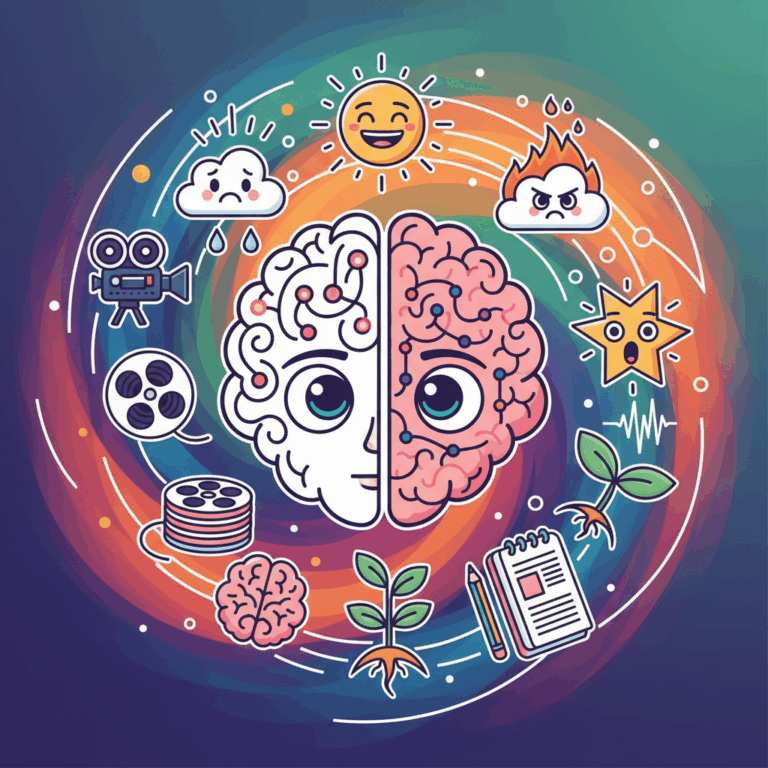Emotions and human development in animation
The animation explores in depth the emotions and human development through symbolic narratives that connect with the viewer on a psychological level. The characters undergo internal transformations that reflect universal conflicts.
This medium not only entertains, but also richly represents the emotional world, addressing topics such as... self-esteem, the resilience and the identityinviting reflection on personal growth from childhood to adulthood.
Characters and emotional processes
Animated characters often face complex emotional processes that reflect internal change and evolution in the face of psychological challenges. These processes reveal their struggle with fears, desires, and inner conflicts.
By presenting these experiences, animation facilitates identification with human emotions, promoting empathy and recognition of the importance of emotional states for personal and social development.
Furthermore, these characters act as symbolic reflections of real experiences, helping to understand the management of feelings such as sadness, joy, or frustration and their impact on psychological well-being.
Psychological conflicts represented
Animated stories depict key psychological conflicts, such as the struggle for identity, the fear of rejection, and the process of self-acceptance, which are fundamental to healthy human development.
Many stories explore overcoming emotional wounds and building self-esteem through interaction with other characters, emphasizing the importance of social support and self-exploration.
These conflicts not only provide emotional depth, but also allow us to address topics in humanistic psychology, showing the potential for change and the search for meaning as the basis of inner growth.
Notable examples in animated films
Animated films use profound stories to reflect human emotions and real psychological problems. These works promote reflection and self-knowledge.
With complex characters, these films connect with audiences of all ages, exploring themes such as identity, acceptance, and emotional growth through animated art.
Exploring emotions in “Inside Out”
“Inside Out” features inner emotions as protagonists, showing how joy, sadness, fear, anger, and disgust interact to guide the human mind.
This film helps to understand the importance of accepting all emotions, even negative ones, for a healthy emotional balance and psychological development.
Through an innovative visual and narrative approach, it facilitates the understanding of complex internal processes and promotes empathy with one's own emotional experiences.
Existential reflection in “Soul”
“Soul” delves into questions about the meaning of life and personal authenticity, exploring the relationship between passion, purpose, and individual identity.
The story invites us to value the essentials of existence and find meaning in small moments, generating an accessible philosophical reflection through animation.
This film represents a prime example of how animation can address complex existential themes, stimulating self-awareness in the audience.
Relationships and acceptance in “Beauty and the Beast”
The relationship between Belle and the Beast illustrates how acceptance and empathy can heal deep emotional wounds and transform previous negative perceptions.
This story shows the power of respect and love to overcome prejudice and fear, promoting personal growth through human connection.
Furthermore, it reflects how differences can be a source of enrichment, fostering values of tolerance and understanding among people.
Self-esteem and growth in “Pinocchio” and “Aladdin”
The films "Pinocchio" and "Aladdin" address the search for identity and self-esteem, showing learning processes and mistakes that contribute to emotional development.
These stories highlight the importance of emotional support and facing challenges as drivers of personal growth and maturity.
Both stories inspire us to understand that authenticity and inner values are key to achieving happiness and self-realization.
Psychological impact on the audience
Animation has a profound impact on the audience by promoting the development of empathy and openness to one's own and others' emotions, facilitating human connection.
This medium not only entertains, but also opens spaces for emotional reflection, helping the viewer to understand and manage complex feelings in their daily life.
Developing empathy and emotional openness
Animated stories encourage the empathy by presenting characters with universal emotions that reflect internal conflicts common to the human experience.
This identification allows the audience to understand and feel what others experience, expanding emotional openness and strengthening interpersonal relationships.
Furthermore, by confronting fears and overcoming them, the films teach that vulnerability is a natural and positive part of personal growth.
Reflection and self-knowledge through animation
The animation invites the reflection about one's own emotional and psychological life, stimulating self-knowledge through symbolic stories and visual symbolism.
Through personal situations and dilemmas, the viewer is motivated to explore their values, fears, and internal motivations, promoting mental well-being.
This process helps both children and adults recognize the importance of managing their emotions for healthy psychological development.
Animation as an educational and emotional tool
Animation combines fantasy with emotional reality to create a space where emotions can be explored and learned in an accessible and meaningful way. This approach facilitates emotional education and self-awareness.
By using visual resources and symbolic narratives, animation allows the audience to connect with deep feelings, promoting reflection and psychological growth in an attractive and understandable format.
Fantasy and emotional reality
Animation uses fantasy to visually represent complex and real emotions, creating accessible metaphors that help to understand abstract psychological processes.
This mix allows difficult topics, such as fear or sadness, to be addressed safely and creatively, facilitating identification and emotional management in viewers of all ages.
Furthermore, fantasy in animation fosters imagination and the existence of multiple emotional interpretations, enriching the educational experience beyond literal reality.
Learning and psychological growth
Animated stories promote emotional learning by showing examples of overcoming adversity, resilience, and self-awareness, essential ingredients for healthy psychological development.
By identifying with the characters and their challenges, viewers can reflect on their own emotions and internal processes, fostering empathy and emotional intelligence.
In this way, animation becomes a valuable tool for teaching emotional skills, helping children and adults to face life with greater understanding and well-being.






